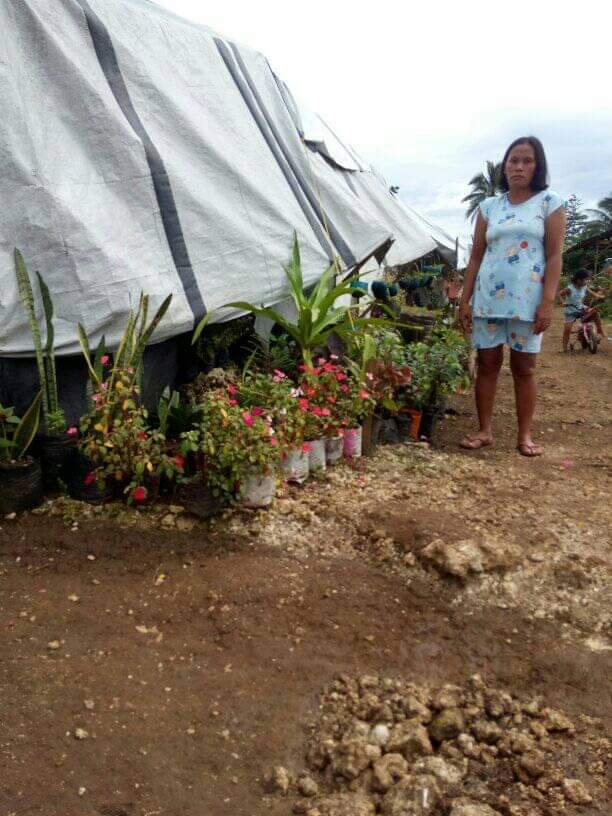Julibeth Angal or “Lalay” as she is fondly called by her family and friends, is a 45 – year old mother of five and a grandmother to three children. She is a member of the Taguibawa tribe formerly living in the mountainous area of Sitio Kapatagan, Brgy. Luayon, Makilala, Cotabato.
Lalay helps her husband plant corn, palay, rootcrops and vegetables which are their main source of food. She also helps in rubber tapping as additional income for the family to survive and to be able to send her two children to school.
The 2019 deadly earthquakes in Cotabato was very traumatic for Lalay and her family. She witnessed how her house collapsed and the wave-like movement of the ground causing cracks and landslides that claimed the lives of her three neighbours. At that very moment, she lost her house, livelihood, and the lives of neighbors close to her family. Worse, their community was isolated instantly as the roads were blocked with big boulders and trees due to landslides and rockslides.
When the magnitude 6.6 earthquake occurred on October 29, 2019, Lalay was running away from the falling debris inside their house when she was thrown away outside by the strong shakes. She sustained wounds but she still managed to command her family members to get out of their collapsing house. She also checked the situation of her other missing children, neighbours and relatives nearby. They tried to rescue a woman neighbour who fell into a cracked portion of the land. But the ground shaking was so intense that the woman died instantly.
As their own immediate response, the 60 families in the village including Lalay’s family, put up small tents as their temporary shelter on safer grounds. Nobody informed them where the other families in the neighbouring villages went. So, they sent someone who can check the situation at the barangay center only to find out that most of them have already evacuated. Everyone was shocked and no one knew where they were going.
It took them four days in isolation and one day to reach the nearest and safest evacuation center. They trekked down to the next barangay carrying with them almost nothing. The elderly and sick were left in the mountains. They lost contact with their own barangay officials, so they sought rescue assistance from another barangay for their families who were left behind.
Since November 2019, Lalay and the rest of the 365 families have been residing at the Evacuation Center in Sitio Flortam, Batasan, Makilala, Cotabato.
Their life at the evacuation center is quite difficult and risky; also prone to floods during rainy seasons and fire due to congestion. Tents are too hot during the day while too cold in the evening. Poor health and sanitation put them at risk of infectious diseases especially the elderly and the children who have been getting sick. Food is very limited and movements are controlled. Going back to their farms is very challenging. The road is still blocked with stones and landslides and ground shaking is still experienced. Farms are still highly susceptible to landslides.
To survive, Lalay ‘s family and their neighbours planted vegetables for food and started a flower garden to generate additional income while staying at the evacuation center. They had to do something to be able to buy food and just a few toiletries.
The COVID-19 pandemic was also challenging for Lalay. Her worries over her underaged children and grandchildren and her senior parents began to take toll on her mental and emotional well-being.
She found a new purpose and motivation when she began participating in the DRR activities under the Enhancing Capacities project supported by the German humanitarian organization Diakonie Katastrophenhilfe and being implemented by the Disaster Response Center, Inc. (DIRECT).
Although the DRR sessions are very limited and mobility is restricted, she still managed to share the information gathered from the CBDM sessions with other members of the community. Lalay also mobilized the youth to be part of the DRR activities.
The earthquake simulation drills conducted during the CBDM Training of Trainers made Lalay realize there’s truth to the expression that constant practice makes perfect. She knew now that being prepared would somehow lessen the effects of the earthquakes. Her experience with the earthquake’s wave-like movements would have been less hazardous if she and her family and her neighbors made structural assessments of their houses when the first quakes happened. They could have saved themselves from injury and the traumatic experience of witnessing their houses collapse and the death of someone close to them.
Lalay found a new advocacy in disaster preparedness and mitigation. She says that she is still trying to absorb everything but she took to heart the importance of being prepared in case another earthquake or other hazard strikes.
“I don’t want to experience that feeling of helplessness anymore. Life is very hard inside the evacuation center, especially now that there’s a pandemic. But I know that there are still things that we can do. We still want to go back to our normal lives though. But while waiting for that to happen, we can find ways to survive. We need to educate ourselves and learn how to be more prepared when another emergency happens,” Lalay said.

